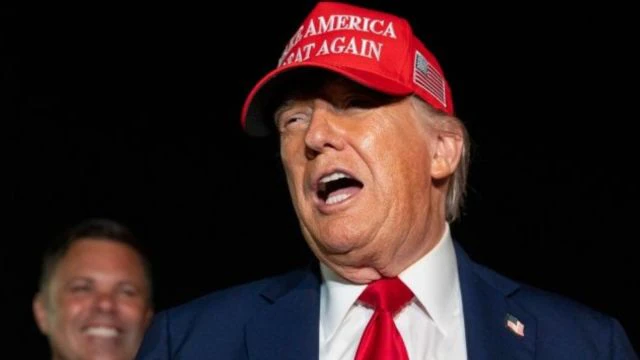Trump’s 50% Tariffs Slam Indian Exports — Textiles, Gems & Jewellery Industries Face Biggest Shock

Image via The Indian Express
Wednesday, August 27, 2025 — A major trade jolt hit India today as U.S. President Donald Trump’s new 50% tariffs on Indian imports officially came into effect. This sudden hike is being described as one of the biggest blows to India’s export sector in recent years. Industries such as textiles, gems and jewellery, garments, leather goods, seafood, and chemicals are the worst affected.
The new duty is a sharp jump from the earlier 25% tariff rate. It was announced as part of Washington’s pressure on New Delhi over its continued purchase of Russian oil. According to U.S. officials, the tariff is meant to be a “punitive measure,” but for Indian exporters, it feels like a punishment on jobs, small businesses, and economic growth.
⚠️ A Trade Shock for India
Indian exporters woke up to an uncertain morning as orders from the U.S. faced immediate cancellations and renegotiations.
- Garment factories in Tirupur and Noida reported calls from American buyers asking for steep discounts.
- In Surat, textile units said they may have to cut production if orders dry up.
- Jewellery traders in Mumbai’s Zaveri Bazaar called it a “doomsday tariff,” warning that thousands of artisans and small workshop owners will lose business.
Exporters fear that countries like Vietnam, Bangladesh, and Mexico may now gain advantage in the American market since they do not face such steep tariffs.
📊 $48 Billion Worth of Exports at Risk
The U.S. is one of India’s largest export destinations. Nearly $48 billion of annual exports are now under direct threat due to the new tariff.
The most affected products include:
- Textiles & garments: Shirts, trousers, dresses, and cotton fabrics.
- Gems & jewellery: Diamonds, gold jewellery, and precious stones.
- Leather products: Shoes, bags, and belts.
- Seafood & shrimp: A major source of earnings for coastal states.
- Carpets & handicrafts: Traditional Indian goods that rely heavily on the U.S. market.
Industry bodies estimate that 30% to 70% of shipments may be disrupted depending on product categories. The Federation of Indian Export Organisations (FIEO) said exporters are already losing market share because American buyers are turning to competitors.
📉 Impact on India’s Economy and Jobs
The financial firm Nomura has revised India’s economic growth forecast down to 6% from earlier expectations of 6.5–6.7%. The reason is simple — if exports fall, industries will cut production, which means fewer jobs and lower income for millions of workers.
Sectors such as textiles and jewellery are labour-intensive. They employ:
- Millions of women workers in garment stitching and embroidery.
- Artisans and craftsmen in jewellery polishing.
- Daily wage labourers in small factories.
If orders decline, layoffs are expected in small towns and industrial clusters, hitting India’s working-class families the hardest.
💬 Political Reactions in India
Opposition leaders were quick to target the government.
- Congress leader Jairam Ramesh called it a “massive blow to labour-heavy exports.”
- Critics said India should have prepared better for such shocks by diversifying export markets.
The government, however, stressed that it is in talks with Washington. Officials said that trade tensions should not overshadow the larger strategic partnership between India and the U.S. under platforms like the Quad.
🛡️ Government Plans an Export Shield
India’s Commerce Ministry has announced plans to shield exporters. Some of the measures include:
- Financial support packages for exporters in high-risk sectors.
- Diversification push toward alternative markets like China, Middle East, Africa, Latin America, and the EU.
- Discussions with the Reserve Bank of India to provide working capital relief for gems and jewellery exporters.
- Encouragement to shift part of production to tariff-free countries to bypass U.S. duties.
Despite these efforts, many exporters believe the short-term pain will be unavoidable.
💎 Gems & Jewellery Industry in Crisis
The gems and jewellery industry, worth billions in annual exports, is among the worst hit. Traders say the U.S. is their largest market, and a 50% duty makes Indian diamonds and jewellery nearly unaffordable there.
Many exporters are now exploring:
- Setting up factories in UAE or Mexico, which enjoy easier U.S. access.
- Sending semi-finished goods abroad for final polishing and assembly before re-exporting to America.
- Shifting to alternative markets in Europe and the Middle East.
However, such adjustments take time and investment, leaving small exporters vulnerable.
🧵 Textiles and Garments on the Edge
India’s textile hubs in Gujarat, Tamil Nadu, and Uttar Pradesh are under pressure. Exporters say U.S. buyers are cancelling large bulk orders of shirts, jeans, and cotton products.
Competing countries like Bangladesh and Vietnam are now in a stronger position because they continue to enjoy low tariffs in the U.S. This could result in permanent loss of India’s market share in American retail chains.
Factories in Tirupur, famous for knitwear exports, say they may shut down operations if the situation does not improve in the coming weeks.
🌍 Supply Chain and Global Trade Concerns
India’s emergence as a manufacturing alternative to China may also be hurt. The U.S. tariffs make Indian products less competitive, which could push global buyers back toward China or Southeast Asia.
Trade experts say if the tariff situation continues for months, India could lose its “China plus one” advantage in global supply chains.